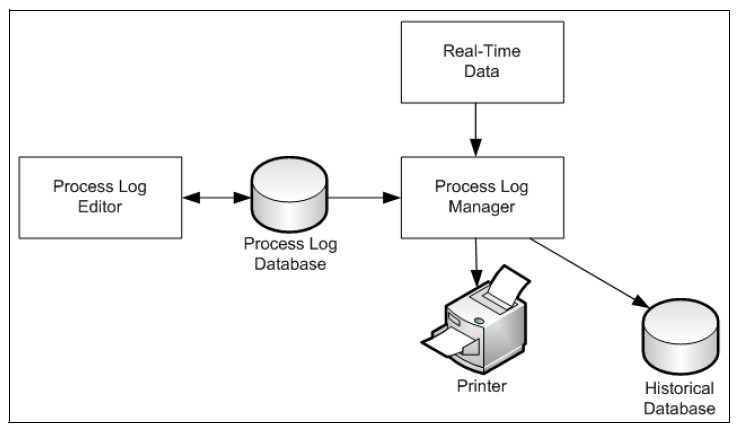Topic 13.1.1: Process Logging
- The Process Logging system captures data at periodic time intervals or based on the occurrence of events, and then logs the data to a printer or to the history database for storage.
- You can create Process Log configurations and store them in the Process Log database. A Process Log configuration consists of one or more groups of tags, with each group having its own logging criteria.
- The criteria control how the groups of tags and their respective values are sampled and logged at run time by the Process Log Manager.

- Process Logger System Overview
- The Process Logger is responsible for retrieving data, at periodic time intervals or events, and passing the data to the History Manager for storage.
- The Process Logger Editor creates logging configurations. A configuration consists of one or more groups of tags with each group having its own logging configuration.
- The Log Manager uses the logging configurations to determine how each group of tags and their respective values should be sampled and logged.
- Each Process Log Configuration consists of one or more groups of tags. Each group specifies its own general logging criteria, consisting of a Log Trigger, Log Event and Data Destination.
- All of the tags that are a part of the process model are available for selection.
- The Process Logger is constantly monitoring the Log Triggers and Log Interval in order to start or stop logging for each group.

- Creating a Process Logger Configuration
- The Process Logger Editor is used to define groups of tags that will be logged in the same manner as defined by the General Logging Criteria for the group.
- To create a Process Log Group, you:
- Create a Process Log configuration
- Create a Process Log group
- Define a trigger and event
- Select the data destination
- Select tags
- General Logging Criteria
- Criteria needed to configure process logging.
- Log Trigger
- The Log Trigger defines the condition(s) that initiate logging for the group. The Log Trigger options are Always and On Event. If Always is selected, logging will begin as soon as the run-time Process Log Manager is started.
- If On Event is selected, a true/false Boolean expression is evaluated. If the result of the expression is true, logging occurs.
- Expressions are defined using the Expression Editor. The Expression Editor is used to create a true/false Boolean expression using any of the tags in the process model. A Boolean expression, for example, could simply be a discrete tag. When the tag is true (value of 1), logging for the group will begin.
- When the tag is false (value of 0), logging will stop. An example is provided later in this section.
- Log Interval
- The Log Interval defines the frequency of sampling for each tag in the group. The interval options are On Event, 2 seconds, 5 seconds, 10 seconds, 30 seconds, 1 minute, 5 minutes, 15 minutes, 30 minutes, 1 hour, 2 hours, 4 hours, and 24 hours.
- If On Event is selected, a true/ false Boolean expression must be defined.
- The Expression Editor is used to create a true/false Boolean expression using any tag in the process model. Each time the expression is true, the data values for each of the tags in the group will be logged.
Last modified: Friday, 8 May 2020, 10:42 AM
